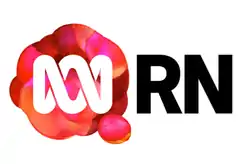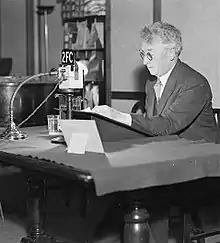Radio National
Radio National, known on-air as RN, is an Australia-wide Public Service Broadcasting radio network run by the Australian Broadcasting Corporation.
 | |
| Broadcast area | Australia |
|---|---|
| Frequency | Various (FM and AM), DAB+, DVB-T Ch-26, online |
| Programming | |
| Language(s) | English |
| Format | News, talk |
| Ownership | |
| Owner | Australian Broadcasting Corporation |
| ABC Classic FM, ABC Local Radio, ABC NewsRadio, Triple J | |
| History | |
First air date | 5 December 1923 |
Call sign meaning | Radio National |
| Links | |
| Webcast | Live stream |
| Website | abc |
Radio National broadcasts national programming in subjects that include news and current affairs, the arts, social issues, science, drama and comedy. Some programs are relayed on Radio Australia, the ABC's international broadcasting service which was transmitted on shortwave until January 2017, as well as 24-hour FM stations, local relay stations and live satellite.[1]
Radio National currently has 327 transmitter sites and covers over 98% of the permanently inhabited areas of Australia. Remote areas are served by satellite service.
All radio programs are available for live streaming over the Internet, and most (excluding drama, poetry and music) as audio-on-demand, or for download as MP3s for at least four weeks after broadcast. Some programs are available as MP3s going back to 2005, when Radio National commenced podcasting.
History

From 1928, the National Broadcasting Service, as part of the federal Postmaster-General's Department, gradually took over responsibility for all the existing stations that were sponsored by public licence fees ("A" Class licences). The outsourced Australian Broadcasting Company supplied programs from 1929. In 1932 a commission was established, merging the original ABC company and the National Broadcasting Service. It is from this time that Radio National dates as a distinct network within the ABC, in which a system of program relays was developed during the subsequent decades to link stations spread across the nation.
Radio National's Sydney station 2FC[2] first test broadcast on 5 December 1923 and officially went to air on 9 January 1924. 2FC stood for Farmer and Company, the original owner of the station before the ABC took it over.
The origins of the other stations in the network were:
- 3AR Melbourne – 26 January 1924 "Associated Radio Company of Australia", organized by Esmond Laurence Kiernan and others.[3][4]
- 5CL Adelaide – 20 November 1924 "Central Broadcasters Ltd"
- 7ZL Hobart – 17 December 1924
- 4QG Brisbane – 27 July 1925 "Queensland Government" (operated by the Queensland Radio Service, an agency within the Office of the Chief Secretary)
- 6WN Perth – 5 October 1938 "Wanneroo"
- 2CY Canberra – 23 December 1938
- 2NA Newcastle – 20 December 1943
The first transmitters for 2FC, 5CL and 4QG were made by AWA with power of 5 kW (note that until about 1931 in Australia, transmitter powers were defined in terms of DC input to final amplifier, typically about 3 times that of the power into the antenna; thus power today would be stated as about 1.7 kW). They used a MT7A valve for the final high power RF stage and a MT7B for the modulator. The power supply was 12,000 volts from three phase power rectified by MR7 valves. 4QG commenced with a 500 Watt transmitter which continued for about 6 months until the 5 kW unit was commissioned.[5]
The radio transmitters for 3AR and 2FC were upgraded to 10 kW in a contract let in 1938 to STC. The transmitters were designed by Charles Strong in London, and were notable in using negative feedback to ensure a high quality flat frequency response.[6]
From 1947 until the mid-1980s, "Radio 2" (as it came to be known) was broadcast to the major metropolitan centres, with a large broadcast footprint in adjacent areas due to the powerful AM transmitters in use. It contained most of the ABC's national programming.
The power level of 2FC and 3AR was upgraded to 50 kW in the early 1950s. The transmitters for these were housed in the same building as the radio 1 network. They were manufactured by STC. The final stage contained three parallel 3J/261E air cooled triodes running in class C amplifier at 90% efficiency. These were driven by a class B push-pull modulator with the same type of valves.[7] That of 5CL had to wait until late 1961, when a new joint facility with 5AN was opened at Pimpala.
In the 1970s, the network's program format began to take on a more serious tone, a style which continues to this day. Art critic Peter Timm later remarked that the network is "virtually the only non-print media forum for art in this country."[8]
In the early 1980s the broadcast footprint was extended with the construction of the first of over 300 regional FM transmitters (including community re-broadcast sites). In 1985, the ABC renamed "Radio 2" as "Radio National".
Since 1990, all Radio National stations have had the same callsign format, Radio National preceded by the appropriate number for the state or territory, sometimes followed by the locality (e.g., "2RN Sydney", "3RN Melbourne").
As a result of cuts in the 1996–97 budget, Radio National was hit with a reduction of a million dollars in its funding, with a significant impact on programming.[9]
In January 2012 Radio National was rebranded as RN, partly in recognition of the stations growing digital audience. RN has also been used as shorthand for the station's name by many presenters going back several years. The stations tagline, which has changed regularly over the years, was also changed to "Your World Unfolding" to mesh with the station's new logo and visual identity.
In January 2017 the schedule was reduced in scope due to loss of staff and programmes.
2008 program schedule controversy
In 2008, controversial programming changes once more raised the issue of funding cuts to the public broadcaster.[10][11][12][13] Presenter Stephen Crittenden leaked confidential Radio National programming changes in an unscheduled live broadcast before the start of his show, vehemently criticising his superiors.[14] Stephen Crittenden was suspended for his outburst, amid criticism from some colleagues for his unprofessionalism and praise from others for his outspokenness.[15] His unscripted comments were cut from Radio National's podcast and transcript of the program, but the subsequent comment by religious commentator Paul Collins on crikey.com reiterated Crittenden's fears.[16] Crittenden was eventually reinstated as a reporter in the flagship investigative program Background Briefing after an independent investigation resulted in a confidential settlement with the presenter.[17] However his program, and the other eight cancelled or merged were not re-instated that year. The head of ABC Radio Sue Howard was dismissed in 2009, partly for the perception that the controversy was mishandled.[18]
In 2012 a new Religion and Ethics report was re-launched hosted by Andrew West. The Media Report was also relaunched, hosted by broadcaster and former Life Matters host Richard Aedy.[19] The Media Report was however cancelled again in 2015.[20]
2017 Music programme and staff removal
In late 2016, the new head of the ABC, Michelle Guthrie, defended the removal of staff and programmes from the Radio National 2017 schedule.[21][22][23]
See also
- Bald Hills Radiator, ABC's AM radio transmission centre in Brisbane
- BBC Radio 4
- List of radio stations in Australia
- Radio New Zealand National
- Timeline of Australian radio
References
- "ABC Exits Shortwave Radio Transmission". About the ABC. Retrieved 5 December 2018.
- 2FC radio mast at Willoughby http://naa16.naa.gov.au/rs_images/ShowImage.php?B=3025014&S=1&T=P National Archives of Australia circa. 1920 Retrieved 18 December 2008
- On This Day Vic Parliament
- Aussie Callsigns Archived 23 October 2006 at the Wayback Machine at RadioDX
- Winston T. Muscio (1984). Australian Radio the Technical Story 1923–83. Kangaroo Press. p. 66. ISBN 0-949924-82-2.
- Winston T. Muscio (1984). Australian Radio the Technical Story 1923–83. Kangaroo Press. p. 68. ISBN 0-949924-82-2.
- Winston T. Muscio (1984). Australian Radio the Technical Story 1923–83. Kangaroo Press. p. 76. ISBN 0-949924-82-2.
- Timms, Peter. What's wrong with contemporary art? 2004, UNSW Press, ISBN 0-86840-407-1, p. 102
- Budget Review 1996–97 Archived 15 February 2012 at the Wayback Machine Parliament House
- "ABC flagship radio shows axed". Land. Farm Online. 16 October 2008. Archived from the original on 6 July 2011. Retrieved 1 April 2011.
- "Anger as ABC axes specialist programs from Radio National". Canberra Times. Fairfax. 16 October 2008. Archived from the original on 4 October 2011. Retrieved 1 April 2011.
- "Programs axed amid Radio National reshuffle". ABC News. ABC. 15 October 2008. Retrieved 1 April 2011.
- Archived 2 November 2008 at the Wayback Machine
- Archived 22 October 2008 at the Wayback Machine
- "What are they doing to Radio National? God help us!". Crikey. 15 October 2008. Archived from the original on 4 September 2012. Retrieved 1 April 2011.
- "The Australian". Archived from the original on 3 May 2009. Retrieved 8 February 2016.
- Simons, Margaret (17 December 2008). "Goodbye Sue Howard, hello ABC restructure?". Crikey. Archived from the original on 22 December 2008. Retrieved 1 April 2011.
- "Radio National announces new 2012 lineup". Radio National. 23 January 2012. Archived from the original on 26 July 2012. Retrieved 17 July 2012.
- "The Weekly Beast: ABC Radio National dumps Richard Aedy's Media Report". The Guardian. 19 November 2015. Retrieved 5 March 2017.
- Meade, Amanda (8 December 2016). "Jaws drop at ABC as Michelle Guthrie defends Radio National cuts – Weekly Beast". the Guardian.
- Meade, Amanda (15 November 2016). "Radio National to lose eight staff as ABC cuts several programs from 2017 schedule". the Guardian.
- Meade, Amanda (7 December 2016). "ABC board demands director of radio explain Radio National cuts". the Guardian.
External links
- ABC Radio National
- Frequencies from Radio National
- Pool, Radio National's collaborative media space
- Visit the National Film and Sound Archive's Women in Radio collection for more information about the history of women in radio in Australia.